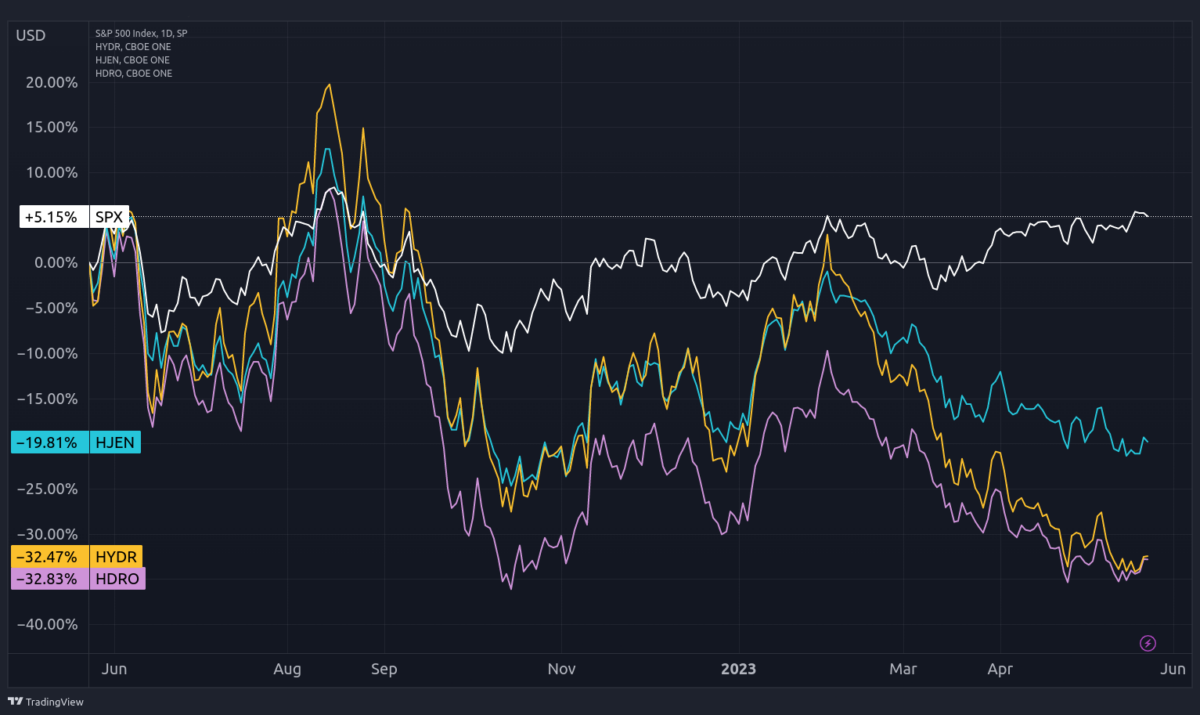A Good Time To Invest In Hydrogen

This week I’m focusing my attention on hydrogen, as an investment theme. This is because of two reasons. First, I believe hydrogen to be a lot better than other alternative energy sources, therefore providing a huge relative upside potential. Second, hydrogen-related companies are trading at a significant discount relative to their record highs in 2021, providing investors with a good entry opportunity.
Although hydrogen is a cleaner replacement for fossil fuels, it has been a less commonly used energy source in recent years because the energy required to produce it outweighs the hydrogen generated. Besides, separating water into hydrogen and oxygen is an energy-consuming complex process. While hydrogen is a clean energy source, the majority of it is produced using fossil fuels. This is known as “grey hydrogen.” The main reason for this is the cost. Grey hydrogen is made from fossil fuels like coal and natural gas using a process called steam methane reforming that emits large amounts of carbon dioxide. In contrast, green hydrogen is obtained by the electrolysis of water using renewable energy sources like solar, wind or hydroelectric energy. The name green comes from the zero to low emissions related to its production.
The hydrogen industry needs an initial boost to invest heavily in I&D to improve the electrolysis process and reduce the cost to produce hydrogen. Several incentives are already in place across the world to boost the production of green hydrogen, including producers tax credits for the first years of their projects’ duration, indirect subsidies, transfer of knowledge, among others. Europe is in an outstanding position, as it has several projects going on and is a key producer of wind and solar energy, necessary to produce green hydrogen. Asia is also investing large amounts in hydrogen projects.
Oil and natural gas prices have been rising over time, creating an incentive to develop alternatives energy sources. The war in Ukraine contributed to raise natural gas prices and exposed the problems of relying on Russian gas, creating an additional incentive for the production of green hydrogen. While green hydrogen is still very expensive in relative terms, the rising investments in hydrogen projects are making the electrolysis process more efficient and cost-effective, which is encouraging hydrogen adoption.
As of 2021, green hydrogen represented just 0.5% of hydrogen’s production. However, this share is expected to grow to 10% by 2030. While most companies operating in the market currently produce dirty hydrogen, their structure is flexible enough to alternate between grey and green hydrogen.

Hydrogen Fuel Cells Versus Lithium-Ion Batteries
Using fossil fuels to produce clean energies seems odd. With most of the hydrogen produced currently deriving from fossil fuels, we can hardly consider hydrogen as a clean energy. Besides, giving the high cost to produce green hydrogen why bother with it at all?
The energy generated through wind and solar must be stored and delivered to where it’s needed. Converting it to hydrogen is usually a good option because of hydrogen’s high energy density per unit of weight, making it an efficient carrier. Therefore, hydrogen allows us to convert energy into a more desirable form.
When used in cars, hydrogen doesn’t require charging, just refilling a tank. For that reason, with hydrogen we don’t need chargers everywhere, but rather adapt the existing gas stations. Moreover, it’s possible to use the conventional internal combustion engines and replace gasoline with hydrogen without any need to build completely new cars. While hydrogen fuel cells are long-lasting, lithium-ion batteries aren’t, and we don’t know how to recycle lithium.
Getting A Piece Of The Market
With the above in mind, I believe we are at an excellent point to invest in hydrogen-related companies. Japan, South Korea, China and Europe are on a fast track towards achieving success in the hydrogen market. Still, there are many US companies working in this market that are worth looking at. However, the legal and economic environment in the US is not as favourable for hydrogen as it is in other regions. Some companies operating in the business worth looking at include: Linde (NYSE:LIN), Air Liquide (FR:AI), Plug Power (NASDAQ:PLUG), Ballard Systems (NASDAQ:BLPD), Fusion Fuel Green (NASDAQ:HTOO), CummIns (NYSE:CMI), Bloom Energy (NASDAQ:BE), Adani Green Energy (IND:ADANIGREEN), Nel ASA (FRA:D7G).
To get a diversified position in the hydrogen theme, there are several ETFs (or UCITS) for US and European investors. For US investors, the best options are: Global X Hydrogen ETF (NASDAQ:HYDR), Direxion Hydrogen ETF (NYSEARCA:HJEN) and Defiance Next Gen H2 ETF (NYSEARCA:HDRO). For European investors, the options are: L&G Hydrogen Economy UCITS ETF USD and VanEck Hydrogen Economy UCITS ETF.
The Global X Hydrogen ETF invests in companies expected to benefit from the advancements of the global hydrogen industry, including those involved in hydrogen production, integration of hydrogen into energy systems and the development and manufacturing of hydrogen fuel cells and electrolysers. It currently invests in 25 stocks and its top holdings are Nel ASA (15.5%), Bloom Energy (10.3%), Ballard Power Systems (8.2%), Plug Power (7.2%) and SFC Energy (6.6%). Other notable companies in the fund are Linde, Toyota Motor and CummIns. Global X provides a global exposure, including to the US (30.9%), the UK (19.6%), Norway (14.3%), Canada (8.1%) and France (6.6%). It is additionally exposed to Sweden, South Korea, Germany and Japan.
It should be noted that this is a high risk investment. The fund’s beta relative to the S&P 500 is 1.74, a very high number. Moreover, several companies in the list aren’t profitable. HYDR suffered a decline of 68% since peaking at $28.57 on 12-Nov-2021 towards its current price at $9.15. However, in my view, this represents a good entry opportunity after some initial hype. Annual expenses are 0.50%. Investors in Europe can access a version of this Global X ETF in the form of UCITS.
The Direxion Hydrogen ETF aims to achieve the same investment objective as HYDR by investing in a group of 30 stocks. Its top holdings include Air Liquide (9.3%), Shell (7.5%), Nel Asa (7.1%), Bloom Energy (6.8%) and Plug Power (5.9%). In terms of country exposure, the top includes the UK (26.0%), the US (21.9%), Japan (12.0%), France (11.4%) and Norway (7.6%). HJEN has less exposure to the US than HYDR and is less concentrated. These small differences rendered HJEN some outperformance relative to HYDR. I would say that the exposures of HJEN are better adjusted for the reality of the hydrogen market than those of HYDR. Annual expenses amount to 0.45%.
The Defiance Next Gen H2 ETF top holdings include Nel ASA (8.6%), Doosan Fuel Cell (6.8%), Ballard Power Systems (6.2%), Green Hydrogen Systems (6.0%) and Plug Power (5.9%). Similarly to HYDR, its top country exposure is the US, which rendered it underperformance relative to the Direxion’s fund. Still, the fund is exposed to several European countries like the other two.
In Europe, the L&G ETF is less exposed to the US and more exposed to Japan and South Korea than Vaneck’s alternative. The European exposure provided by Vaneck is concentrated over Norway and France while it is more evenly spread across Europe for L&G. Annual expenses are 0.49% for L&G and 0.55% for Vaneck.

Conclusion
Hydrogen is theoretically cleaner than other energy sources but still faces technological hurdles before it is widely adopted. Currently, most hydrogen produced comes from dirty energy sources. But the market is changing fast and absorbing huge improvements making the electrolysis process more cost-effective. In my view, electric cars requiring lithium-ion batteries and chargers aren’t part of the future and will lose ground overtime to technologies like hydrogen. But, hydrogen is not only about cars, but also about trucks, planes, heavy machinery and storage. Investors have a good chance to profit from the growing hydrogen sector, which will play a vital role in a more environmentally friendly future. Investing in hydrogen companies is a great opportunity right now because their prices have dropped by 60-80% compared to their highs in 2021. If there’s disruption to occur in the energy sector, it will likely come from hydrogen.
Comments (0)